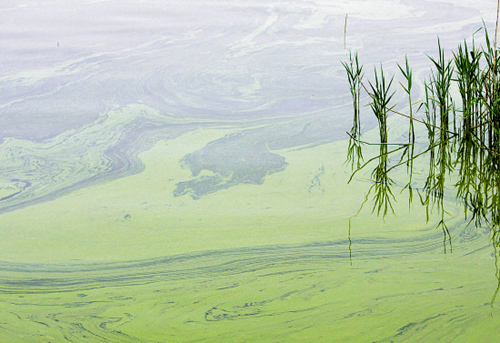Outbreaks of blue-green algae, which sparked last year's water pollution crisis in Wuxi in Jiangsu province, may hit the Taihu Lake again this summer, say some scientists and top environmental officials.

The words "SOS Taihu Lake", written using blue-green algae, are seen on the bank of the lake in this recent photo taken in Yixing, east China's Jiangsu Province. Outbreaks of blue-green algae, which sparked last year's water shortage crisis in Wuxi, Jiangsu Province, may hit Taihu Lake again this summer, say some scientists and top environmental officials. [Xinhua]
"Large-scale outbreaks of blue-green algae are very likely to occur as temperatures rise," says Zhang Lijun, vice-minister of Environmental Protection (MEP), who led a one-week inspection trip in Jiangsu and Zhejiang provinces in early April.
In late March, signs of blue-green algae blooms were spotted in southern part of the Taihu Lake earlier than previous years.
Blue-green algae occur naturally as part of the food chain and is found in the rivers and lakes all over the world. But scientists say blue-green algae can become overly abundant in warm, shallow, undisturbed surface water that receives a lot of sunlight and an overabundance of nutrients, such as nitrogen and phosphorus. Pollution can greatly boost the outbreaks.
Last May, in the lakeside city of Wuxi, a sudden overgrowth of the blue-green algae polluted the intake area for drinking water, which resulted in the suspension of the fresh water supply to half of the 2.3 million city's residents for a week.
Located in the highly developed and densely populated Yangtze River Delta, Taihu Lake, China's third largest freshwater lake has become increasingly polluted in the recent years.
"During the last two decades, the overall water quality of Taihu Lake dropped from the national standard Grade II to worse than Grade V, or unfit for human contact," says Jin Xiangcan, a leading expert on water environment at Chinese Research Academy of Environmental Science, who just finished a research project on algae control at Taihu Lake.
Jin says the excess nutrients in the Taihu Lake were a result of continuous sewage and industrial pollution that provide favorable conditions for algae's growth.
There are no short-term solutions to clear the nitrogen and phosphorus compounds from the lake, says Jin. He adds that the blue-green algae infestation would last at least three to five years, even if all the sources immediately stopped discharging waste into the lake, says Jin.
This is probably the reason that vice-minister Zhang has described the combat to clear Taihu Lake a "a protracted battle." He urged local authorities closely monitor the blue-green algae to ensure that the outbreaks would not again threaten the drinking water supply.
Lacking effective measurements to prevent more blue-green algae blooms, fishing them out was necessary to try to minimize the damage.
But last year, the algae started to decay before it was first removed from the lake and the water soon became foul smelling.
But a branch of the China Shipbuilding Industry Corporation, one of the country's largest ship builders, has finished building ships that could remove the algae and the Wuxi government has arranged for 44 ships to start working this month.
Meanwhile, environmental officials also stressed the local authorities need to increase their monitoring of the industrial wastes, because factories around lake are still discharging wastewater without proper treatment, according to officials from MEP.
Scientific research
Blue-green algae blooms are threatening not only Taihu Lake, but also many freshwater lakes and rivers in China and it is likely that the experience of cleaning Taihu Lake can be useful for other polluted water bodies.
Jin's research on controlling the blue-green algae is one of the demonstration projects of a 13-year State-funded program.
The State council earlier provided an investment of 36.5 billion yuan from 2008 to 2020 to strengthen the scientific research to control and halt water pollution.
"It is the largest scientific research program on water pollution control ever in China in terms of investment and time," Zhao Yingmin, head of the department of science, technology and standards at the MEP, says.
Priorities will be given to the drainage areas of the Huaihe, Haihe and Liaohe rivers, Taihu, Chaohu, and Dianchi lakes, Songhua River and Three Gorges Reservoir area.
Lack of funds, technology, and limited law enforcement resources are among major difficulties facing water pollution control, says Zhao, who said the program is expected to help make up for the technological shortages.

Blue-green algae is seen on the surface of Taihu Lake in this recent photo taken in Yixing, east China's Jiangsu Province. Outbreaks of blue-green algae, which sparked last year's water shortage crisis in Wuxi, Jiangsu Province, may hit Taihu Lake again this summer, say some scientists and top environmental officials.
All About Taihu Lake, Blue algae
(China Daily, Xinhua News Agency, China.org.cn April 23, 2008)